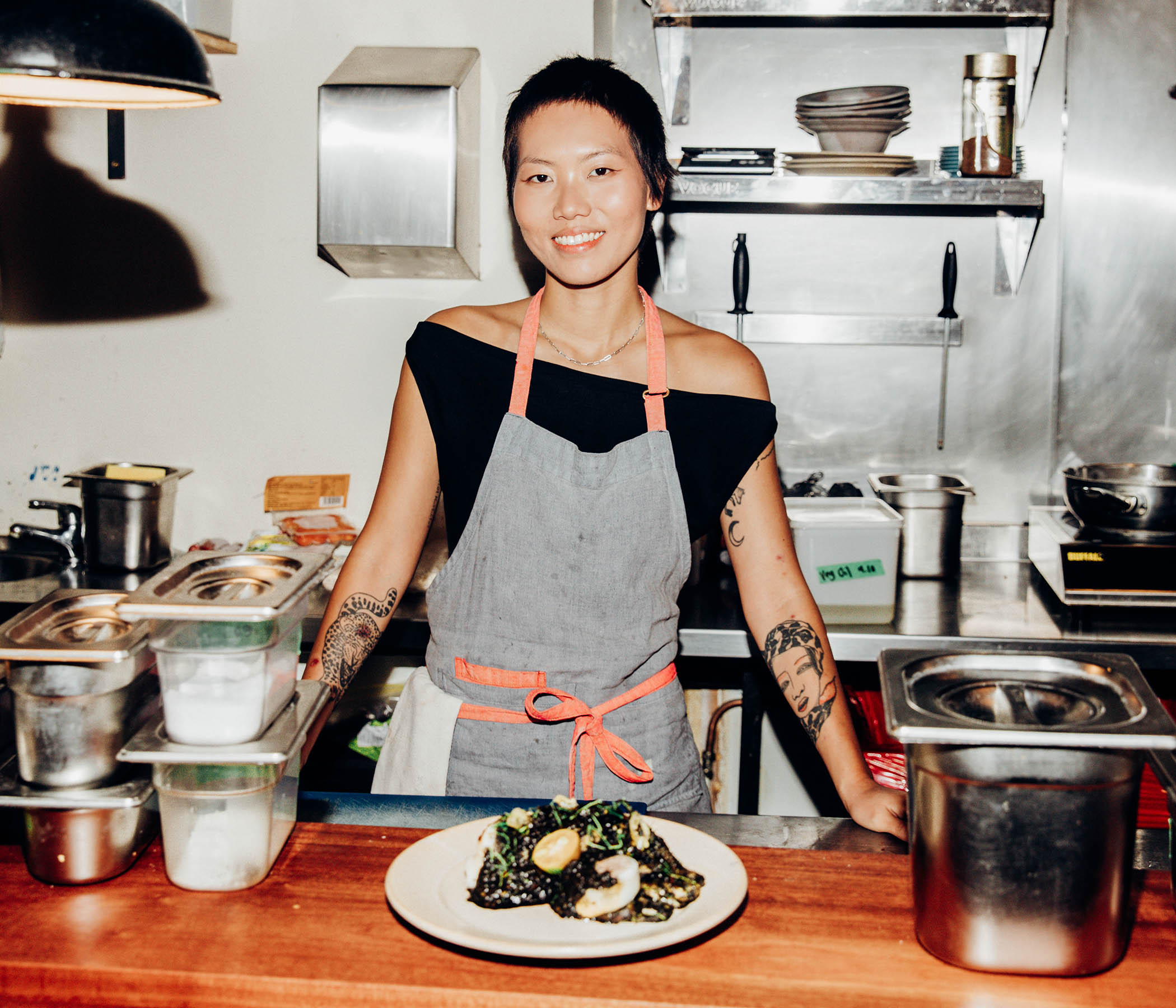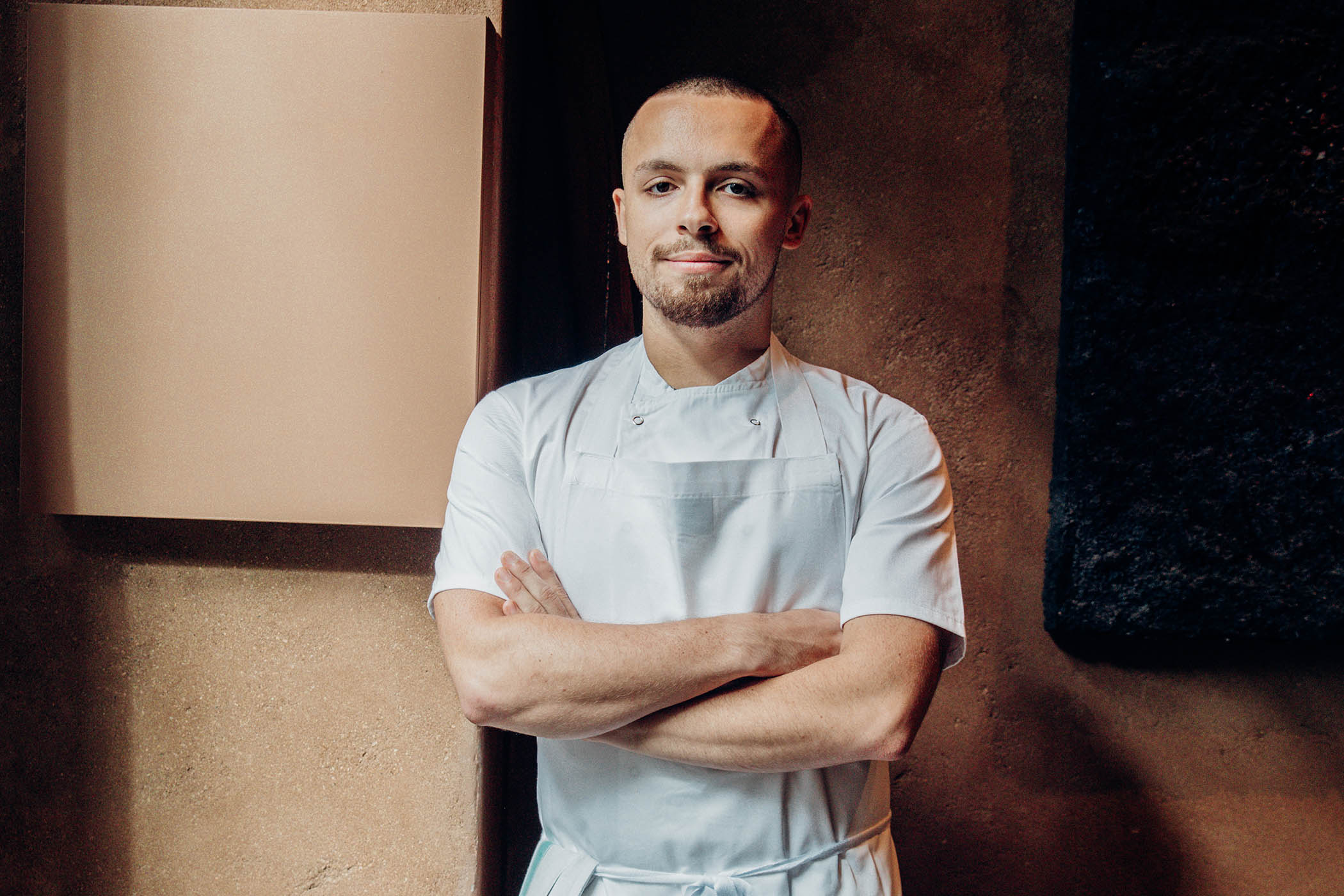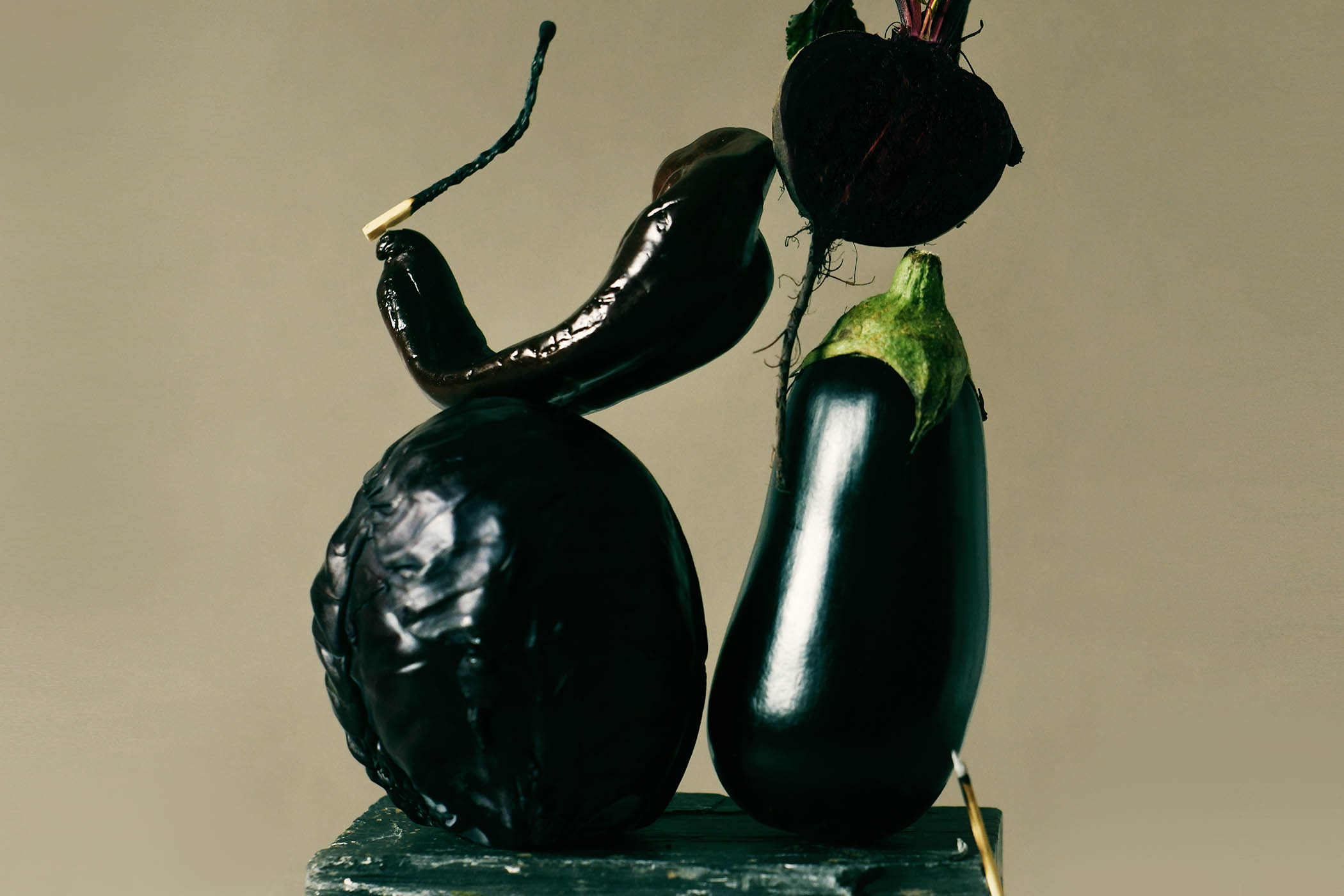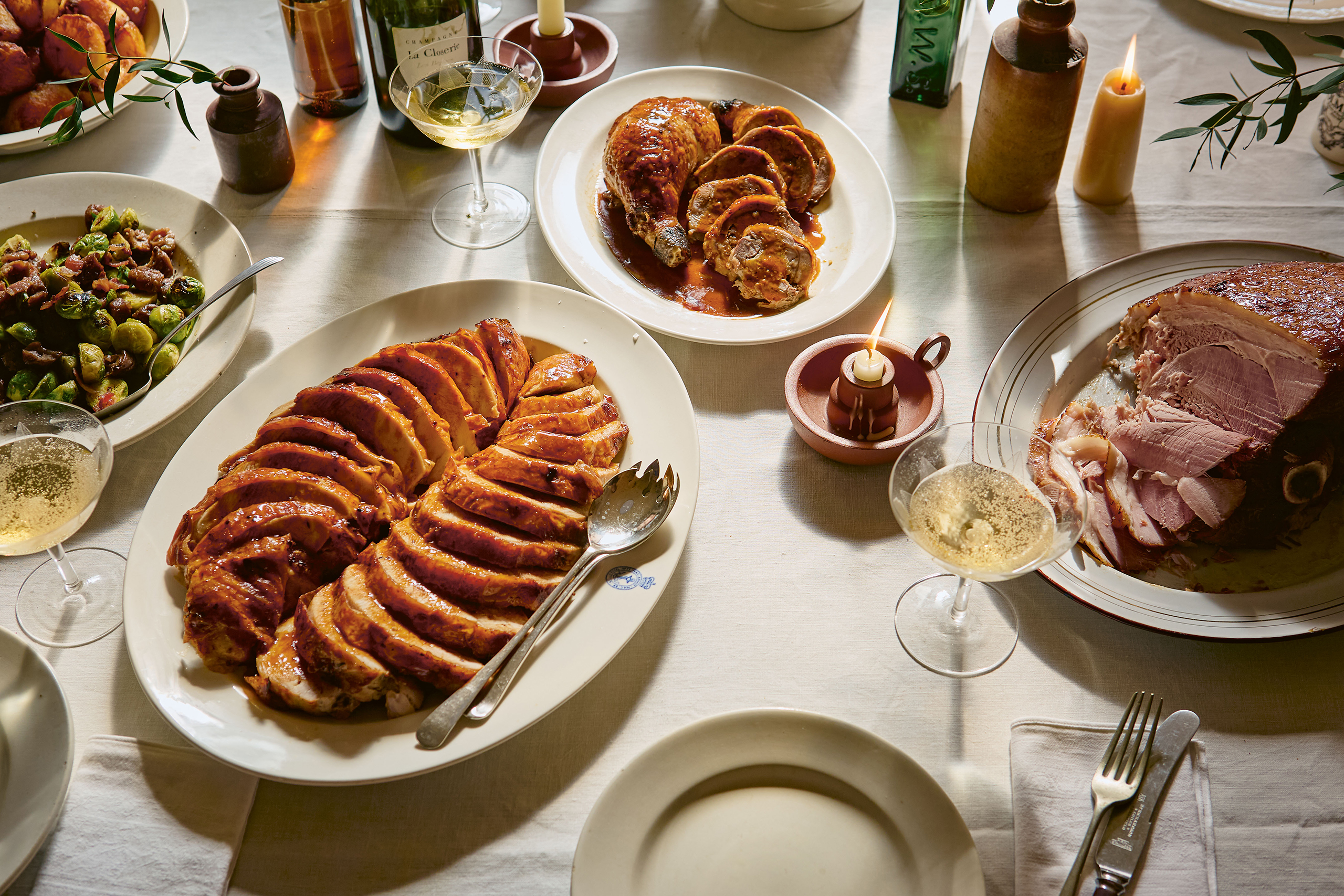Still life Kenneth Lam Portraits Jonathan Daniel Pryce
Earlier this year, chef Merlin Labron-Johnson visited Pierre Touitou’s new restaurant, 19 Saint Roch in Paris. Touitou, whose father has Tunisian heritage, ordered for him, skipping dishes with a clear French through-line in favour of a family recipe. A bowl of jute-mallow and beef stew, called mloukhia, arrived at the table. “It was complex,” he remembers, “almost like a mole,” the earthy Mexican sauce made with chilli or chocolate. It was vegetal and savoury. And it was black.
Back home in Bruton, Labron-Johnson recreated Touitou’s dish using an envelope of spices Touitou had sent him home with. After the traditionally rustic Sunday lunch version came the restaurant interpretation: a generous spoon of satiny black mloukhia sauce on the lamb dish at his fine dining restaurant Osip. Jute-mallow suppliers are scarce in Somerset, but Labron-Johnson, “fascinated by the dish” and its “jet-black slice of sauce” was up for the sourcing headache.
In the past, he’s used black as a mask, concealing complexity beneath a simple-looking exterior. “It’s satisfying, sometimes, to serve something deceptively simple, that just looks like a black circle, but when you cut into it, reveals a lot of layers,” he told me when I visited recently. Last autumn, he made a round of pork sausage-filled squid, then hid the disc in a cloak of glossy squid-ink sauce. The plating was inspired by lievre à la royale, a dish in which a deboned hare is stuffed with foie gras and truffles, then rolled, tied and braised, before being served in a sauce thickened with its blood, which turns black when heated. “It’s heady and interesting,” Labron-Johnson said of the French classic, “reminiscent of an old, complex wine.” Both his squid-ink rendition and the hare take fiddly work and boast powerful flavours – but while blackness suggests a potency of taste, it also disguises components beneath.
Blackness as a disguise, or a hint of something hidden, is part of its enduring appeal. A blanket of white sauce can conceal handiwork, too, but save for the nasal-clearing punch of horseradish, it suggests a safe, indulgent creaminess. A green sauce implies grassy freshness. Black, by contrast, can be endlessly complex, mostly thanks to its relative rarity.
Related articles:

‘Flavour comes before anything else, but the allure of black bread was making fun food’: Lee Tiernan, chef at London’s FKABAM
In nature, the shiny blue-black of a blackberry drupelet is no different from that of atropa belladonna, the toxic perennial. One nourishes, the other kills: Romeo and Juliet’s fatal tonic came from the belladonna. Yet that berry skin is stained by anthocyanins which, when eaten regularly, can reduce free radicals and inflammatory markers. Culinarily blackness can signal danger – decay, mould, char – but just as many black foods are harmless, if not nutritious. Creeping black mould can be toxic, but the mushroomy funk of huitlacoche, an edible fungus that imparts both a prized taste and added nutritional value to corn, is a delicacy. Even the carbonised char of burnt food is as much delicacy as carcinogen: both s’mores and the silky, scooped-out innards of a scorched aubergine wouldn’t be possible without a little blackening.
Increasingly, chefs are embracing black ingredients for both their flavour and drama. Sometimes, like in the Osip kitchen, that blackness suggests an intensity to come; other times, it disguises gentler notes behind a visual trick. Our expectations of a taste-to-colour match runs deep: in the 1990s, Coca-Cola, aiming to capitalise on the associations between clarity, purity and health, introduced Tab Clear – a transparent cola. The product bombed. Diners expect saturated foods (and drinks) to deliver vibrant flavour and colour, and assume the opposite will be wimpy in comparison. Studies of synaesthesia suggest the same. Cross-sensorially, powerful tastes are linked to dark, dim colours and low sounds.
At his plant-based, fine-dining restaurant Plates in London, chef and co-owner Kirk Haworth uses pigment to shake up perceptions. “The diners’ mindset is to be let down,” says Haworth, of the perception of plant-based food as being mild or boring. “Intense colours,” set the expectation. In his black lasagne, Haworth replaces béchamel with a deeply savoury, toasted miso yeast sauce, split with chive oil. Three discs of charcoal-tinted pasta dough hint at the rich tomato ragù layered beneath.
Nearby, chef and co-owner Lee Tiernan approaches charcoal and squid-ink flatbreads in a similar way. At his restaurant FKABAM (Formerly Known As Black Axe Mangal), “Flavour comes before anything else,” he says, “but the allure of black bread was making fun food.” Again, deep colour suggests deep flavours, while, as in Haworth’s lasagne, Tiernan’s flatbreads gain little from their coloured additives beyond looks, the overall dish is punchy. “The flatbreads will have every bit of cook on them, from blond to black,” he says, of pushing his grilling beyond the standard toast. “I think a bit of scorch gives more texture and depth.” His original, the squid-ink rendition, is painted with butter, then spooned with whipped cod’s roe and finished with a jammy yolk.

‘It’s natural for your body to be taken aback by the colour of squid ink’: Abby Lee, chef at Mambow, serves dishes inspired by her Malaysian and Chinese heritage
Of all the black ingredients out there, squid ink (or, more commonly, cuttlefish ink) is a clear chef favourite. “It has salinity, but it’s also earthy and sweet,” says Alex Raij, chef and co-owner of New York’s Saint Julivert Fisherie, La Vara, and Txikito. Raij describes the Basque cooking at Txikito as “austere but sensual,” and few dishes reveal that tension more than those dipped in ink. Whereas many of the colours of Basque cuisine are ruddy, dishes like txipirones en su tinta, which translates to “squid in its own ink”, is glossy and strikingly pure in its blackness but, like much of the cuisine, plated without faff. “It acts like a lacquer or patent leather,” Raij says, who folds drips of the ink through aioli, where it becomes “pearlescent” and grates the dried variation over hamachi crudo.
Abby Lee – chef-owner of east London’s Mambow – also likes the way a squid ink sauce captures the diner’s attention. Last year, Lee served a rendition of sotong masak hitam (the Malaysian dish of squid in its own ink). She added pork sausage to the traditional squid as a nod to her mixed Malaysian and Chinese heritage. “Some guests were quite intimidated,” she says. “It’s just natural for your body to be taken aback by the colour of squid ink.”
That is just one element of the surprise of black foods for Lee. “Often, people see black and they expect a charcoally burnt flavour, whereas I think of hyper-caramelised flavours: sweet and burned,” she says. In reality, her dish, with a backbone of coriander root, ginger, tamarind and white pepper, “was actually quite lifted,” with “tangy, sweet, and savoury notes.”

‘It’s about adding drama to a dish’: Josh Root, pastry chef at Akoko
At Sollip, in south London, a black dessert reveals some of those flavour notes Lee mentions, but just as many that diners have come to expect from tamer, paler shades. Here, pastry chef and co-owner Bomee Ki soaks a round of charcoal-laced brioche in burnt vanilla custard, on which she plates a scoop of ice-cream and tuille, both flavoured with the vegetal and sweet Seoritae, a Korean black bean. Back up in central London, at Akoko, it’s black sesame seeds, not black beans, that lend earthiness to dessert. Pastry chef Josh Root chose black seeds over white both for their strong nutty flavour and the “drama” they impart on the precise little squares of fudge.
Black food, it turns out, isn’t always hiding heady flavours. It can now and then be sweet, lifted and delicate. For chefs, that unpredictability is part of the colour’s pull. Far simpler, and more elegant, than the meat-fruit trompe l’oeils and smoke-filled cloches is just the mysterious black sauce, and the joy of being, as Raij says, a little disoriented by dinner.


